CAVE
Thomas R CAVE
- Masatsugu MINAMI - (Director of the OAA Mars Section)
from CMO #198 (25 December 1997)
Tom CAVE, Jr
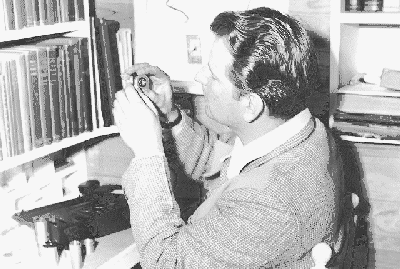 Tom CAVE is known as one of the most celebrated elders in the world of
the Mars observation in the US: He started his career as a Mars observer
from the 1935 opposition when he was just around 13 years of age, and thus
the year before last in 1995 he welcomed his 60th anniversary of observing
the red planet Mars. It was very natural that the ALPO congratulated him for
his long life as a serious observer of Mars in July 1996 (see LtE in CMO #
182 p1961). In the oriental countries the number 60 has a special good
implication because it is the least common multiple of 10 and 12.
Tom CAVE is known as one of the most celebrated elders in the world of
the Mars observation in the US: He started his career as a Mars observer
from the 1935 opposition when he was just around 13 years of age, and thus
the year before last in 1995 he welcomed his 60th anniversary of observing
the red planet Mars. It was very natural that the ALPO congratulated him for
his long life as a serious observer of Mars in July 1996 (see LtE in CMO #
182 p1961). In the oriental countries the number 60 has a special good
implication because it is the least common multiple of 10 and 12.
Tom examines an ocular in 1948
In addition to his life as a planetary observer, Tom CAVE has also been well
known as a superb optician and maker having good gliding and polishing
techniques and has long been an owner of Cave Optical Company from which he
provided a great number of telescopes to the world.
We should also recall
that he has played an instructive role in amateur-astronomy world especially
for the younger generations. For instance Samuel WHITBY recalls that,
although they have never met in person, Sam has been aware of Tom's
contributions since Sam's childhood, for Tom has published numerous articles
that were instructive to the young Sam. (See Sam's LtE in this issue for
more details.)
It should again be noted that he is still an active
observer of Mars who showed up several times in the present journal CMO even
this year, and it is our pleasure to pay homage to Tom CAVE on this occasion
here by learning back his younger days.
15cm f/10 Reflector
We hear it was 8 years old in 1930 when he was first attracted by
Astronomy by visiting the Adler Planetarium in Chicago several times. He was
at that date deeply influenced by an uncle in-law who was an MIT Master of
Science.
His family moved to Los Angeles in 1931 and then to Long Beach
in the early spring of 1934 where he began to practise the dark skies and
telescopes. He also read some books on astronomy for pre-teenagers. He began
to learn the constellations by naked eyes plus a pair of binoculars used in
WWI. In summer vacation time when he was in the sixth grade of elementary
school in 1934, he earned some money by mowing neighbour's lawns to buy an
achromatic 6.3cm refractor-tube assembly which was equipped with a 20mm
eyepiece. He remembers clearly the day it reached him at the beginning of
the 1934 autumn. Here his father, Tom CAVE Sr, made an appearance to provide
his son with a set of tripod having an equatorial mounting. The skies at
Long Beach was dark enough to watch several stellar objects.
Meanwhile
Tom Jr came to know the existence of the Long Beach Telescope Makers Club on
a newspaper, and this became very decisive to him in several senses. First
he was led to have a free kit of a 15cmx2.5cm thick plate glass from which
he tried to make an f/10 mirror. This was really well polished and figured
since he was helped by several professional opticians. The tube which
accommodated the speculum needed a 150cm length as well as the Mt Wilson's
250cm type mounting. This was again helped by CAVE Sr. This telescope was
completed by the 1934 Christmas, and already his parents had given him three
Ramsden eyepieces by J E MELLISH which gave him magnifications 90x, 180x,
and 310x.
Those days, the Telescope and Astronomy Clubs at the district
were very active, and several f/6 and f/7 Newtonians were possessed by the
members. However CAVE Jr, upon visiting and trying to watch the lunar and
planetary objects by use of these shorter telescopes, was somewhat
disappointed at the performances and became convinced that f/9 - f/11
Newtonians could give much clearer and sharper images of the planets. Note
that this conviction occurred to a boy at the age of 12. The boy was thus,
as it were, father to the latter Tom CAVE.
In 1935, he watched the
Messier objects, clusters, double stars as well as planets by using both
telescopes. Especially he began to view the planet Mars by the 15cm f/10
reflector and made some rough drawings of the markings. Mars was at
opposition in April. Tom detected Syrtis Major and Mare Acidalium. He also
read some books which he obtained at the second-hand bookstore: For example
he bought P LOWELL's first book on Mars published in 1895 at a cost of 2
dollars.
Apparitions of Mars in 1937 and 1939
In 1937 Mars was closest to the Earth in May. This was the apparition
when Tom began his systematic series of the Mars observations by use of the
15cm f/10 reflector, and he made a few dozen drawings during the season. The
best dozen were sent to Harold B WEBB at Long Island, NY and they were
published later. The 1937 apparition was therefore the first fruitful one
for Tom, just 60 years ago and the same time when Tsuneo SAHEKI here in
Japan observed the planet at the Kwasan Observatory (see CMO #175 p1840).
The same year Tom read through W H PICKERING's Mars Reports at the Long
Beach Central Library.
In 1938 summer, Tom went to Chicago and at the
basement of the Adler Planetarium he met Edwin P MARTZ Jr who in turn told
him of the addresses of some lunar and planetary observers including Walter
H HAAS, Hugh M JOHNSON and Frank VAUGHN. In 1939 Tom began to correspond
with these observers, and exchanged the observations. In 1939, Tom observed
intensively the planet Mars which approached perihelically the Earth in July
(the maximal apparent diameter was 24.1 arcsecs). He obtained a considerable
number of drawings. He learned also how to use the American Ephemeris.
The Los Angeles Times then carried an article on Mars written by a
professional astronomer at Mt Wilson Observatory, and Tom wrote a letter to
the Observatory and immediately received a reply from Dr Robert RICHARDSON
who invited Tom to Mt Wilson to observe Mars by use of a 150cm reflector. On
the appointed evening, a relative of Tom's drove him up; the seeing was very
good that night and the view of Mars was very excellent: Since then until
his death, Dr RICHARDSON was a close astronomical and social friend of Tom's.
25cm f/11.2 Reflector and the 1941 Apparition
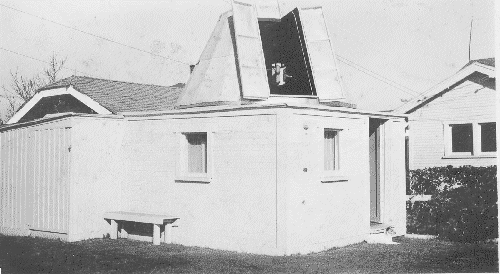 In early spring of 1940, his family purchased a home in a best
residential part of Long Beach, and Tom and his father built a 4.2mx4.2m
square observatory having a dome imitating Mars Hill's one. He made a 25cm
Pyrex mirror having 280cm focal length in a square plywood tube mounted on
the German form of equatorial mount.
In early spring of 1940, his family purchased a home in a best
residential part of Long Beach, and Tom and his father built a 4.2mx4.2m
square observatory having a dome imitating Mars Hill's one. He made a 25cm
Pyrex mirror having 280cm focal length in a square plywood tube mounted on
the German form of equatorial mount.
CAVE's Mars-Hills-type Observatoy at Long Beach in 1940
In 1941 Mars was at opposition in
October and the year was very fruitful to Tom: In January 1941 he finished
high school, and at once secured employment through the Los Angeles
Astronomical Society at Herron Optical Company (for 60 hrs a week). At night
he was rather free at home and was able to observe Mars from May to December
and obtained a total of 254 numbers of drawings. This is still his record
number for one season. Most drawings were made using loaned Zeiss & Leitz
orthoscopic and monocentric oculars (far better than Ramsden).
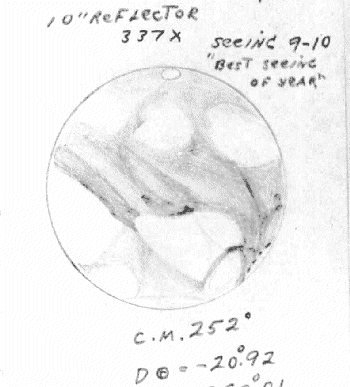 In October
Tom detected a marking which was new to him near at LCM=200° W , and so sent
the drawing to Dr E C SLIPHER at Lowell. Within days, a reply came from E C
SLIPHER himself who identified the marking to be the detached Lastrygonum
Sinus. SLIPHER asked Tom to send more sketches and in November he invited
Tom to join the Lowell staff as an observing assistant of the planets. It
was a honour to Tom, but since he was working as an apprentice optician at
Herron Optical Co, he felt he had to turn down the offer.
In October
Tom detected a marking which was new to him near at LCM=200° W , and so sent
the drawing to Dr E C SLIPHER at Lowell. Within days, a reply came from E C
SLIPHER himself who identified the marking to be the detached Lastrygonum
Sinus. SLIPHER asked Tom to send more sketches and in November he invited
Tom to join the Lowell staff as an observing assistant of the planets. It
was a honour to Tom, but since he was working as an apprentice optician at
Herron Optical Co, he felt he had to turn down the offer.
After the US entered WWII, the Herron Optical employees zoomed up from
21 to 155, while Tom himself was enlisted in the US Army: He was sent in the
European theatre, and a few days
after the liberation of Paris on 25 August 1944, he had a chance to visit
the Meudon Observatory which was his only astronomical experience he had in
Europe during the war time.
From Tom's drawing in 1941 (340x 25cm spec)
16 Oct 1941 (Ls=292°, LCM=252°W, De=21°S)
Returning home at the beginning of 1946, Tom entered the University of
Southern California (which was located only a few block walk from Herron
Optical Co) and at the same time he went back to work at the Company 40 hrs
a week doing optical work on motion pictures. With study and work, in the
1946 apparition (opposition in January 1946) he could not obtain more than
ten or twelve drawings of Mars.
At Lowell Observatory in 1948
Prior to the 1948 aphelic apparition (opposition in February), Tom made a
20cm f/10 reflector which was mounted on a Thomas Cooke & Sons clockdriven
equatorial mount.
In the 1948 Easter break Tom attended the meeting at
Lowell and met for the first time E C SLIPHER, V M SLIPHER and C O LAMPLAND.
E C SLIPHER allowed Tom to observe the planet for several nights by use of
the Clark 60cm Refractor: Tom on the occasion much learned about the
planetary visual observations. He thus made observations of Mars at Lowell
as well as by use of the 20cm Reflector.
31cm Monster Telescope
The monster 31cm f/11.3 Newtonian built in 1950: Tom at age of 27
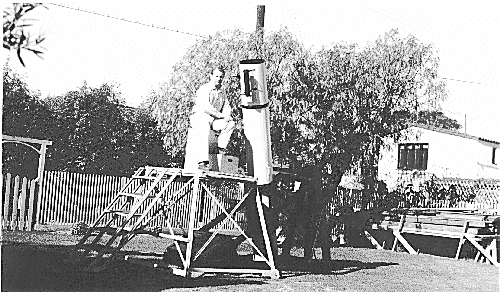 In 1949 he ground and polished a 31cm speculum having a 335cm focal
length. This was accommodated in a long rotating tube of 3.6m (12 feet) in
length which was electrically clockdriven. This telescope was probably the
best ever Tom made, and gave good performances under good seeing allowing
400x, 800x. He used this monster in the 1950 and 1952 apparitions. O R
NORTON, who once worked under Tom CAVE, wrote later (S&T vol 88 August 1994
issue p88) about his first experience meeting with this telescope as
follows: " I arrived at 265 Roswell Av and passed through the gate to the
backyard --- and into another world. Before me stood a leviathan of a
telescope, so large that it would have taken a 12-foot ladder to reach the
eyepiece."
In 1949 he ground and polished a 31cm speculum having a 335cm focal
length. This was accommodated in a long rotating tube of 3.6m (12 feet) in
length which was electrically clockdriven. This telescope was probably the
best ever Tom made, and gave good performances under good seeing allowing
400x, 800x. He used this monster in the 1950 and 1952 apparitions. O R
NORTON, who once worked under Tom CAVE, wrote later (S&T vol 88 August 1994
issue p88) about his first experience meeting with this telescope as
follows: " I arrived at 265 Roswell Av and passed through the gate to the
backyard --- and into another world. Before me stood a leviathan of a
telescope, so large that it would have taken a 12-foot ladder to reach the
eyepiece."
Cave Optical Company
Still attending the USC, he polished a lot of 15cm, 20cm, 25cm and 31cm
specula for amateurs in Los Angeles and before December 1950 he had made
more than 900 mirrors. CAVE Sr so decided that Tom should run his own
optical business in a 9mx26m store a mile apart from their home. CAVE Sr
built several modified Draper polishing machines and et al. In mid-December 1950, CAVE Sr and Jr entered full time business: They received a
large order for the primary mirrors, and then for tube assemblies and the
mounting systems, and by late 1951 they were to do the telescope business;
this becoming eventually Cave Opitical Company. This Company continued until
1980, and for the last ten years they had 30 - 35 employees and 8 persons who
figured mirrors and objective lenses.
NORTON also belonged to the Company
and tells us an episode about CAVE Sr who was a wonderful man: " One day in
the middle of one of these (coffee) breaks, the secretary called Cave to the
front office. Although Cave was never harsh or demanding, he returned from
there red faced and obviously upset, numbing something unrepeatable about
his father. Cave Sr ran the business affairs of Cape Optical and was
essential to its early success. He also had wonderful handwriting. With a
diamond pencil he scribed the Cave Optical signature on the back of each
mirror, complete with focal length and mirror number. Each mirror was fine
ground flat on the back, clearly distinguishing it from the front. But on
that day the elder Cave had blundered: a just-completed 6-inch mirror on his
desk bore the beautiful Cave Optical inscription ---on the front! We never
let him forget that day." NORTON also writes " I regret that I did not have
him scribe a mirror for me in his Old English style. A thousand mirrors bear
his distinctive mark, and lucky is the amateur who has one." The present
writer wonders if Alan HEATH's Cave mirror has the Old English signature or
not.
CAVE Sr passed away in 1957, and since then CAVE Jr became Thomas
CAVE.
International Mars Committee and IMP
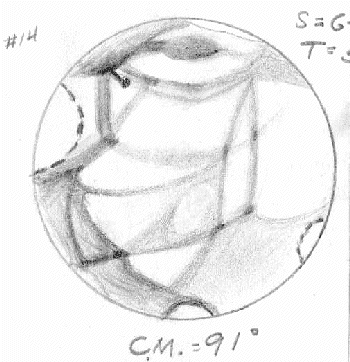 In 1953 Tom was invited in Colorado to join the International Mars
Committee. In 1954, 1955, and 1956 it was held at Lowell. Tom attended all
of these meetings. (The Japanese Committee of the IMC was then held asked by
E C SLIPHER and organised by I YAMAMOTO, President of the OAA.) The
outgrowth must have been the International Mars Patrol in America. The late
Charles (Chick) CAPEN and Tom observed Mars three apparitions in the 1960's
from the JPL Table Mountain Observatory. The CAPENs had a nice cabin as well
as a guest cabin; Tom's late wife and two teenaged daughters stayed many
weekends when Tom was observing with CAPEN using 40cm and 60cm telescopes.
The seeing at the Table Mountain was often excellent.
In 1953 Tom was invited in Colorado to join the International Mars
Committee. In 1954, 1955, and 1956 it was held at Lowell. Tom attended all
of these meetings. (The Japanese Committee of the IMC was then held asked by
E C SLIPHER and organised by I YAMAMOTO, President of the OAA.) The
outgrowth must have been the International Mars Patrol in America. The late
Charles (Chick) CAPEN and Tom observed Mars three apparitions in the 1960's
from the JPL Table Mountain Observatory. The CAPENs had a nice cabin as well
as a guest cabin; Tom's late wife and two teenaged daughters stayed many
weekends when Tom was observing with CAPEN using 40cm and 60cm telescopes.
The seeing at the Table Mountain was often excellent.
Tom played a role
of Assistant Recorder of the ALPO Mars Section from April 1969 to January
1974 when CAPEN was the Recorder.
27 Mar 1950 ( 400x 20cm Newtonian )
Ls=096°, LCM=091°W, AppDia.=14.4"
Tom also visited several times E C SLIPHER when he was in the residence
at Lowell. The Mars Committee Conferences had many notable professional
astronomers one of whom Tom met was Andrew E DOUGLASS (1867 - 1962). Note
that DOUGLASS lived nearly one century: He observed Mars in 1892 with W H
PICKERING in Peru with a 33cm Refractor and two years later at Flagstaff as
a staff of P LOWELL. He often used a 20cm Clark Refractor and a 90cm Stewart
Reflector stopped down to 33cm for Mars observations.
Great Apparition in 1956
27 Mar 1965 ( 500x 33cm Newtonian )
Ls=088°, LCM=247°W, AppDia.=12.5"
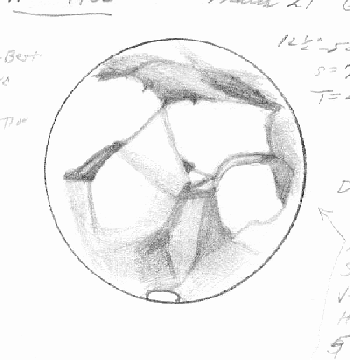 In 1956 and again in 1971, Tom was invited by Robert RICHARDSON to
observe the red planet with him at Mt Wilson by use of the 150cm and 250cm
telescopes, both using the Coude focus. On 10 August 1956 (the App Dia =21.8", 240°
Ls), they had a perfect seeing for longer than 30 minutes on the 250cm Coude
and observed visually with 1000x, 2500x, and even over 3000x. This must
have been quite the same experience as E M ANTONIADI had on 20 September
1909 at the eyepiece of the 83cm refractor when the sky over Meudon was very
calm for half an hour, but Tom and RICHARDSON believed that they had a far
better visual look on the 250cm, and thus they forgot to take pictures. Tom
writes: "The planet had extremely fine details and we felt that we were
flying over the planet. The view was the most amazing one of Mars perhaps
anyone has ever had from land-based stations. The steady view was totally
beyond human description. There were no canals, just only exceeding fine
broken details . . . . Mts of Mitchell detached from the spc. At no other time
have I seen more than 10% or 15 % that we saw that night."
In 1956 and again in 1971, Tom was invited by Robert RICHARDSON to
observe the red planet with him at Mt Wilson by use of the 150cm and 250cm
telescopes, both using the Coude focus. On 10 August 1956 (the App Dia =21.8", 240°
Ls), they had a perfect seeing for longer than 30 minutes on the 250cm Coude
and observed visually with 1000x, 2500x, and even over 3000x. This must
have been quite the same experience as E M ANTONIADI had on 20 September
1909 at the eyepiece of the 83cm refractor when the sky over Meudon was very
calm for half an hour, but Tom and RICHARDSON believed that they had a far
better visual look on the 250cm, and thus they forgot to take pictures. Tom
writes: "The planet had extremely fine details and we felt that we were
flying over the planet. The view was the most amazing one of Mars perhaps
anyone has ever had from land-based stations. The steady view was totally
beyond human description. There were no canals, just only exceeding fine
broken details . . . . Mts of Mitchell detached from the spc. At no other time
have I seen more than 10% or 15 % that we saw that night."
As he
remembers, another occasion of near perfect seeing occurred to him in
October 1941 at his Observatory using 25cm f/11 when he saw clearly Iuventa
Fons as a tiny black drop of ink with a perfect diffraction ring around it.
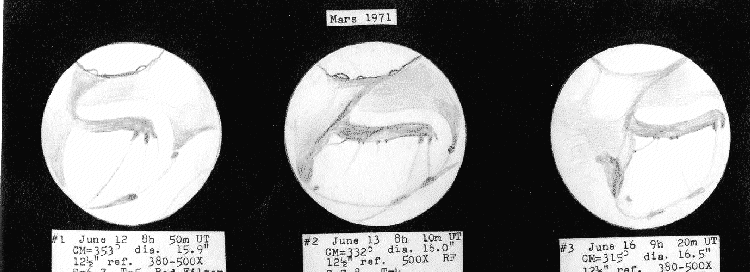
From left to right:
12 June 1971 (Ls=196°, LCM=353°W);
13 June 1971 (Ls=197°, LCM=332°W);
16 June 1971 (Ls=198°, LCM=312°W)
Three from 197 drawings made in 1971 much before opposition around when AppDia.=16" by use of 500x 31cm spec
Recent Years
Anyway as to the telescopes amateur planetary observers use, Tom has
believed in the system of Newtonian, and produced and provided a great
numbers of Newtonians having good specula to the world of thousands of
amateur astronomers. However this showed a slight retrospective aspect
because recent years the shorter Schmidt- Cassegrains or otherwise more
rough Dobsonians have become popular. This fact brought some difficulties to
the business of Cave Optical Co at the end of the 1970's.
Furthermore in
the spring of 1979, Tom seriously suffered from kidney illness and nearly
died, as he describes. Hospitalised for many weeks and receiving a massive
operation and needed a rehabilitation at home, he was at last forced to sell
the business which he maintained for more than 30 years: During the time,
Cave Optical Co produced 83,000 prime-mirrors including refiguring of the
amateur-made mirrors and a large number of mirrors made for NASA, the
largest having a 75cm diameter. Telescopes including the optical tubes and
equatorial mounts are totalled over 16,000.
Tom then ran an optical shop
for Hughes Aircraft Co and worked briefly for Perkin Elmer, but retired in
1988.
Tom has remained however to be a Mars observer, and he has long been
our member of the CMO.
We have missed to mention the telescopes he is
using at present. We expect he himself will mention the story of these
telescopes in the future. (Or see the S&T photo-illustrations in NORTON's
article.) The main must be a 32cm Newtonian with a shorter focal length to
be housed in the old square Observatory. It is piggybacked by a 14cm Clark
Refractor of which he looks to be proud. We should note that by the use of
the 32cm spec he contributed to us this 1996/97 apparition a total of 33
drawings of the red planet. After all, he has been watching Mars about over
3000 times since 1935, and we sincerely hope he will continue at least up
until the upcoming great apparition in 2003.
Acknowledgements
We are very thankful to Tom for his kind information and labour, and
furthermore for giving us his precious photos and drawings to be produced
here.
We are also indebted to Sam WHITBY who has encouraged us to write
about Tom, kindly phoned Long Beach up and communicated several informative
points to us.
Turn to the Façade / Back to the CMO Home Page / Back to Members
 Tom CAVE is known as one of the most celebrated elders in the world of
the Mars observation in the US: He started his career as a Mars observer
from the 1935 opposition when he was just around 13 years of age, and thus
the year before last in 1995 he welcomed his 60th anniversary of observing
the red planet Mars. It was very natural that the ALPO congratulated him for
his long life as a serious observer of Mars in July 1996 (see LtE in CMO #
182 p1961). In the oriental countries the number 60 has a special good
implication because it is the least common multiple of 10 and 12.
Tom CAVE is known as one of the most celebrated elders in the world of
the Mars observation in the US: He started his career as a Mars observer
from the 1935 opposition when he was just around 13 years of age, and thus
the year before last in 1995 he welcomed his 60th anniversary of observing
the red planet Mars. It was very natural that the ALPO congratulated him for
his long life as a serious observer of Mars in July 1996 (see LtE in CMO #
182 p1961). In the oriental countries the number 60 has a special good
implication because it is the least common multiple of 10 and 12. In early spring of 1940, his family purchased a home in a best
residential part of Long Beach, and Tom and his father built a 4.2mx4.2m
square observatory having a dome imitating Mars Hill's one. He made a 25cm
Pyrex mirror having 280cm focal length in a square plywood tube mounted on
the German form of equatorial mount.
In early spring of 1940, his family purchased a home in a best
residential part of Long Beach, and Tom and his father built a 4.2mx4.2m
square observatory having a dome imitating Mars Hill's one. He made a 25cm
Pyrex mirror having 280cm focal length in a square plywood tube mounted on
the German form of equatorial mount. In October
Tom detected a marking which was new to him near at LCM=200° W , and so sent
the drawing to Dr E C SLIPHER at Lowell. Within days, a reply came from E C
SLIPHER himself who identified the marking to be the detached Lastrygonum
Sinus. SLIPHER asked Tom to send more sketches and in November he invited
Tom to join the Lowell staff as an observing assistant of the planets. It
was a honour to Tom, but since he was working as an apprentice optician at
Herron Optical Co, he felt he had to turn down the offer.
In October
Tom detected a marking which was new to him near at LCM=200° W , and so sent
the drawing to Dr E C SLIPHER at Lowell. Within days, a reply came from E C
SLIPHER himself who identified the marking to be the detached Lastrygonum
Sinus. SLIPHER asked Tom to send more sketches and in November he invited
Tom to join the Lowell staff as an observing assistant of the planets. It
was a honour to Tom, but since he was working as an apprentice optician at
Herron Optical Co, he felt he had to turn down the offer. In 1949 he ground and polished a 31cm speculum having a 335cm focal
length. This was accommodated in a long rotating tube of 3.6m (12 feet) in
length which was electrically clockdriven. This telescope was probably the
best ever Tom made, and gave good performances under good seeing allowing
400x, 800x. He used this monster in the 1950 and 1952 apparitions. O R
NORTON, who once worked under Tom CAVE, wrote later (S&T vol 88 August 1994
issue p88) about his first experience meeting with this telescope as
follows: " I arrived at 265 Roswell Av and passed through the gate to the
backyard --- and into another world. Before me stood a leviathan of a
telescope, so large that it would have taken a 12-foot ladder to reach the
eyepiece."
In 1949 he ground and polished a 31cm speculum having a 335cm focal
length. This was accommodated in a long rotating tube of 3.6m (12 feet) in
length which was electrically clockdriven. This telescope was probably the
best ever Tom made, and gave good performances under good seeing allowing
400x, 800x. He used this monster in the 1950 and 1952 apparitions. O R
NORTON, who once worked under Tom CAVE, wrote later (S&T vol 88 August 1994
issue p88) about his first experience meeting with this telescope as
follows: " I arrived at 265 Roswell Av and passed through the gate to the
backyard --- and into another world. Before me stood a leviathan of a
telescope, so large that it would have taken a 12-foot ladder to reach the
eyepiece." In 1953 Tom was invited in Colorado to join the International Mars
Committee. In 1954, 1955, and 1956 it was held at Lowell. Tom attended all
of these meetings. (The Japanese Committee of the IMC was then held asked by
E C SLIPHER and organised by I YAMAMOTO, President of the OAA.) The
outgrowth must have been the International Mars Patrol in America. The late
Charles (Chick) CAPEN and Tom observed Mars three apparitions in the 1960's
from the JPL Table Mountain Observatory. The CAPENs had a nice cabin as well
as a guest cabin; Tom's late wife and two teenaged daughters stayed many
weekends when Tom was observing with CAPEN using 40cm and 60cm telescopes.
The seeing at the Table Mountain was often excellent.
In 1953 Tom was invited in Colorado to join the International Mars
Committee. In 1954, 1955, and 1956 it was held at Lowell. Tom attended all
of these meetings. (The Japanese Committee of the IMC was then held asked by
E C SLIPHER and organised by I YAMAMOTO, President of the OAA.) The
outgrowth must have been the International Mars Patrol in America. The late
Charles (Chick) CAPEN and Tom observed Mars three apparitions in the 1960's
from the JPL Table Mountain Observatory. The CAPENs had a nice cabin as well
as a guest cabin; Tom's late wife and two teenaged daughters stayed many
weekends when Tom was observing with CAPEN using 40cm and 60cm telescopes.
The seeing at the Table Mountain was often excellent. In 1956 and again in 1971, Tom was invited by Robert RICHARDSON to
observe the red planet with him at Mt Wilson by use of the 150cm and 250cm
telescopes, both using the Coude focus. On 10 August 1956 (the App Dia =21.8", 240°
Ls), they had a perfect seeing for longer than 30 minutes on the 250cm Coude
and observed visually with 1000x, 2500x, and even over 3000x. This must
have been quite the same experience as E M ANTONIADI had on 20 September
1909 at the eyepiece of the 83cm refractor when the sky over Meudon was very
calm for half an hour, but Tom and RICHARDSON believed that they had a far
better visual look on the 250cm, and thus they forgot to take pictures. Tom
writes: "The planet had extremely fine details and we felt that we were
flying over the planet. The view was the most amazing one of Mars perhaps
anyone has ever had from land-based stations. The steady view was totally
beyond human description. There were no canals, just only exceeding fine
broken details . . . . Mts of Mitchell detached from the spc. At no other time
have I seen more than 10% or 15 % that we saw that night."
In 1956 and again in 1971, Tom was invited by Robert RICHARDSON to
observe the red planet with him at Mt Wilson by use of the 150cm and 250cm
telescopes, both using the Coude focus. On 10 August 1956 (the App Dia =21.8", 240°
Ls), they had a perfect seeing for longer than 30 minutes on the 250cm Coude
and observed visually with 1000x, 2500x, and even over 3000x. This must
have been quite the same experience as E M ANTONIADI had on 20 September
1909 at the eyepiece of the 83cm refractor when the sky over Meudon was very
calm for half an hour, but Tom and RICHARDSON believed that they had a far
better visual look on the 250cm, and thus they forgot to take pictures. Tom
writes: "The planet had extremely fine details and we felt that we were
flying over the planet. The view was the most amazing one of Mars perhaps
anyone has ever had from land-based stations. The steady view was totally
beyond human description. There were no canals, just only exceeding fine
broken details . . . . Mts of Mitchell detached from the spc. At no other time
have I seen more than 10% or 15 % that we saw that night."